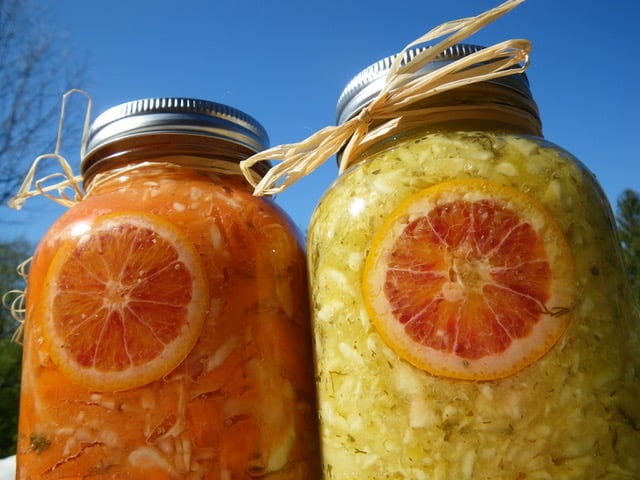4 Immune Boosting Herbs and Easy Cultured Vegetable Recipe
If there’s one message that I want to be able to highlight (and even shout it from a megaphone!) is that an anti-inflammatory diet is one of the best possible defenses we have against viruses. As I say, what you eat today alters your gut microbiome for tomorrow. What you put in your body today has the power to help strengthen immunity during a time when we all need it most.
Historically, viruses come in waves. We’re in the first wave at the moment – there is a strong probability of a second wave happening in the Fall/Winter. In the event you want to make a change to your diet, check with your doctor first in the event you have a health condition. Even if you want to switch back to something next year, fine! We all need to do what we can to boost our immunity now.
In figuring out how to disseminate answers to people’s questions, we want to share as much as we can publicly so everyone can learn. While at the same time, we also want to try to give you information in bite-sized nuggets knowing that you’re being given a ton of information at once and life is a bit overwhelming at the moment.
So let’s go over some basics, and then get to something that you can make today to help the gut and immune system…
Depending on what research you look at, anywhere from 70–80% of your immune system is found within your gut.
Besides cells belonging to the immune system, your gut also contains a whole world of microbial residents. These communities of bacteria and yeast interface with your immune system, shooting signals back and forth that either inflame the body or soothe it. These signals either increase your risk of infection or minimize it.1 Genomics or even underlying viruses can come into play here as risk factors as well.
Yet, one of the easiest ways to either strengthen or rebuild the inner ecosystem of the gut and support the immune system is with cultured vegetables (CV’s), a natural super-probiotic. These types of probiotics don’t exist on the shelves of a store. They’re derived from the fermentation process and they are the most potent bacteria that can survive the harsh environment of the stomach (please note, if you have SIBO, this will not apply to you at the moment – once your symptoms are gone, then you may be able to add CV’s to your diet).
So let’s talk about something that you can easily do at home right now to fortify your microbiome with some super-probiotics (with each meal!)…
There are varying legendary renditions about the group of thieves that escaped the Black Plague by robbing the sick of the following 4 herbs to use as an antidote. In modern day, however, we know just how potent their antiviral properties are.2,3,4
4 Thieves Herbs:
- Rosemary
- Thyme
- Sage
- Lavender
While the Black Plague was a result of bacteria, these four herbs are potent antivirals.2,3,4 Because they are natural herbs, they do not damage the inner ecosystem in the gut or the immune system.
When we culture vegetables with the “four thieves,” we give our body valuable tools to ward off infection.

RECIPE: Cultured Vegetables with the 4 Thieves
Ingredients:
- 1 large head of green cabbage, shredded (set aside 4–5 whole outer leaves)
- 1/2 TB fresh rosemary (1/4 TB dried)
- 1/2 TB fresh thyme (1/4 TB dried)
- 1/2 TB fresh sage (1/4 TB dried)
- 1/2 TB fresh lavender (1/4 TB dried)
- 1 clove garlic, crushed and minced
Steps:
- Dissolve one package of Body Ecology’s Veggie Starter Culture in ¼ cup warm water.
- Add EcoBloom to feed the starter. (Optional, but highly recommendeded because of the enormous support it gives to the probiotics as a prebiotic)
- Allow the starter to rest and “bloom” for 20 minutes or longer. While the starter rests, combine cabbage, herbs, and garlic in a large bowl.
- Remove ½ of the mixture and blend with enough water to create brine.
- Add Veggie Starter Culture to the brine.
- Pour the brine into the bowl with the remaining shredded cabbage, herbs, and garlic. Gently mix.
- Pack the mixture tightly down into as many pint or quart sized glass jars as necessary. Press out as much air as possible, leaving 2 inches from the rim for veggies to expand.
- Roll up outer cabbage leaves into a tight “log” and place on top, filling the remaining 2 inch space. Clamp jars closed or tightly screw on the lid.
- Let veggies ferment on the counter at approximately 70 degrees Fahrenheit or at room temperature for 1–2 weeks. Refrigerate to slow down fermentation.
Recommended Products:
- Veggie Starter Culture: the super power probiotics needed to make the cultured vegetables
- EcoBloom: the powerful prebiotic that is used as an enormous support food for the probiotics in the cultured vegetables
REFERENCES:
- Dinan, T. G., & Cryan, J. F. (2012). Regulation of the stress response by the gut microbiota: implications for psychoneuroendocrinology. Psychoneuroendocrinology, 37(9), 1369-1378.
- Aruoma, O. I., Spencer, J. P. E., Rossi, R., Aeschbach, R., Khan, A., Mahmood, N., … & Halliwell, B. (1996). An evaluation of the antioxidant and antiviral action of extracts of rosemary and Provencal herbs. Food and Chemical Toxicology, 34(5), 449-456.
- Nolkemper, S., Reichling, J., Stintzing, F. C., Carle, R., & Schnitzler, P. (2006). Antiviral effect of aqueous extracts from species of the Lamiaceae family against Herpes simplex virus type 1 and type 2 in vitro. Planta medica, 72(15), 1378.
- Stashenko, Elena, Martínez, Jairo René. Study of Essential Oils Obtained from Tropical Plants Grown in Colombia. IntechOpen. Published: July 16th 2019. DOI: 10.5772/intechopen.87199









